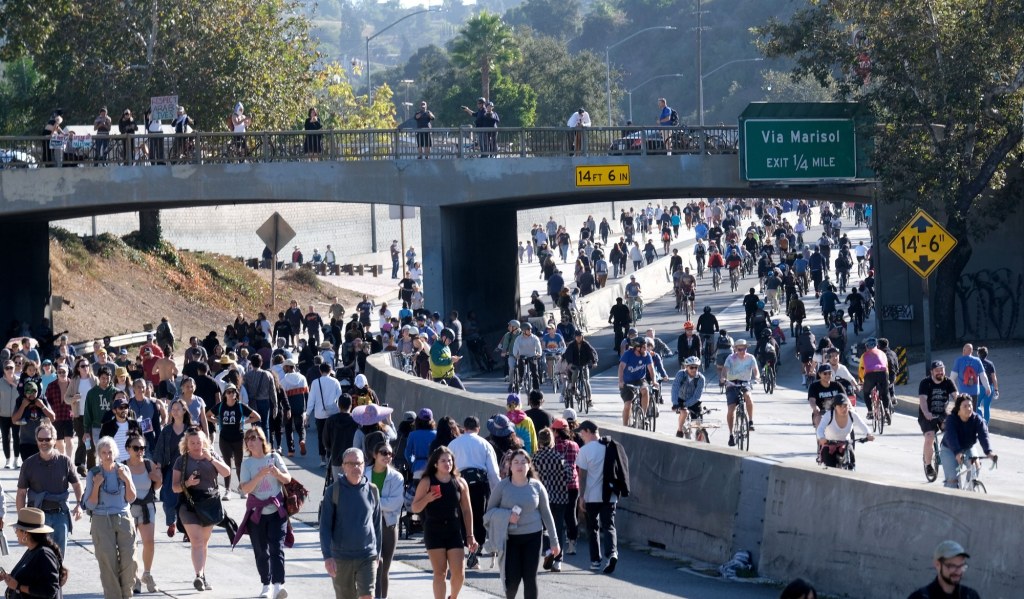6 intriguing things new census data tells us about Southern California – Orange County Register

Humans tell stories about humans.
It’s a basic rule of communication, and it’s worked pretty well for everybody from Shakespeare to Tony Morrison to Dr. Seuss.
But when it comes to telling stories about lots of humans – particularly lots of humans who live in the same general area – a better narrator can be numbers.
That’s what makes new data issued this month by the U.S. Census Bureau so important. The numbers, based on results of the 2020 Census and the ongoing American Community Survey, don’t say any one thing about any one person, but they do say a lot about a lot of us.
Who do we live with? How poor are our kids and our seniors? What languages do we speak at home? How long are our commutes?
The basics are simple: The Census Bureau totes up the entire country once every 10 years in a headcount that provides a well-educated guess about the numbers of people who live in every state, county and city. The census also tracks racial and ethnic identities and, recently, the countries our families came from.
But newly released census data also layers in results from the American Community Survey, which is the bureau’s smaller, year-by-year questionnaire about dozens of topics, everything from education to health insurance to how we make a living. Those numbers – used by the federal government to determine how and where to spend money – say a lot about how we live.
On the surface, the new numbers solidify two well-known local facts:
First, the overall population of the region that includes Los Angeles, Orange, Riverside and San Bernardino counties is shrinking. Sure, there’s been some moving within the four counties, and not all four counties are in decline, but the overall headcount is down slightly in recent years, particularly during the COVID-19 pandemic.
Also see: Where do people go when they leave California and why?
Second, Southern California remains arguably the most racially, ethnically and linguistically diverse region in a wildly diverse nation.
But other numbers get into commuting and aging and child-rearing, and dozens of other issues connected to our daily lives. With that in mind, here’s some of what the numbers say about Southern California.
Escape from L.A.
If you blend data released this week with some other recent numbers (population estimates compiled each non-census year based on tax data) you see that from the start of 2020 through July 2022 the populations of Los Angeles and Orange counties shrunk, by nearly 3% and 1% respectively. Those dips, combined, added up to about 300,000 fewer humans in the region, outweighing the modest population gains seen in smaller Riverside (about 2%) and San Bernardino (about 0.5%) counties.
But the data points out something new about the region’s decline: who left.
During that two-year window, Los Angeles County’s huge (3.3 million) foreign-born population fell by about 220,000, more than offsetting increases in the foreign-born headcounts in the other three counties. That get-outta-Los Angeles vibe hasn’t dented the region’s strong international flavor – as of this year, about 1 in 3 people living in Los Angeles and Orange counties, and 1 in 5 in Riverside and San Bernardino counties, were born in another country.
But, in the eyes of some people, a shift is underway that might mean Southern California won’t be a de facto landing point for so many of the nation’s new arrivals.
Also see: 11% fewer Americans moved to the state over 5 years
“I helped a family, originally from India, move from Santa Monica to Nashville a few months ago,” said Cindy Martinez, a real estate agent who works in west Los Angeles. “They had strong connections here, I think, but they really needed to relocate.
“I’m guessing that could be an interesting transition,” she added. “The (real estate agent) in Nashville said that city is pretty diverse these days. We’ll see, I guess.”
The national rate of foreign-born residents is about 13.9%, or 1 in 7. In Nashville, if you’re wondering, it’s about 12.9%.

Raising flags
The new census data includes information about lineage, tracking which countries people came from, or where they think their ancestors came from.
For foreign-born residents, Mexico is the top spot of origin in all four counties, though several Asian countries – China, Vietnam, South Korea and the Philippines – are big contributors to the local population, with many of the arrivals from China and South Korea coming after 2010.

Among non-Latino White people who answered questions about family ancestry, the top nation of origin in all four counties was Germany, followed by England, Ireland and Italy.
Talking points
English is the most common language in Southern California, but not by a lot.
In Los Angeles County, English is the most popular by a plurality, spoken at home by about 46% of all households. In the other three counties, English is spoken in more than half the homes, but none of the majorities is overwhelming. Overall, in the four counties, Spanish is spoken at home by about 5.8 million people ages 5 and older, more than a quarter of all adults in the region. Still, that number shows Spanish is in decline, locally – five years ago more than 6 million Southern California adults were speaking Spanish at home.
But English isn’t always picking up the difference.

In Los Angeles County, Chinese (including both Mandarin and Cantonese, according to census data) is the No. 3 language, spoken by about 369,000 people, followed by Tagalog (205,000). Meanwhile, Armenian, (173,000), has overtaken Korean (165,000) as the county’s fifth-most common language.
The linguistic scene is different in Orange County, where Spanish (spoken by about 738,400 adults) is followed by Vietnamese (194,000), Chinese (95,700), Korean (73,200) and Tagalog (52,300). But the county’s fastest-growing language is Farsi, which is spoken by 47,500 adults, up 57% since 2018.
In Riverside County, Spanish is spoken by more than 807,000 adults, followed by Tagalog (34,500) and Chinese (25,400). The county’s fastest-growing language is Arabic, which is spoken by about 21,700 adult residents, a nearly three-fold jump over the past five years.
It’s a similar story in San Bernardino County, where Spanish is spoken by 769,000 adults followed by Chinese (43,500) and Tagalog (25,600). The next most popular language, Arabic (18,000), has gained 61% over the past five years.
Birthdays
The power of big numbers can work in different ways, sometimes masking change by making it seem slow-moving or, in some cases, highlighting shifts that should be slow-moving but aren’t.
An example of the should-be-slow-moving-but-isn’t category is the pace of aging in Southern California.
Also see: How an age shift in Southern California’s population could change everything
First, the whole country – along with most of the economically advanced world – is aging rapidly. People are living longer and having fewer kids, causing the focus of the U.S. population to shift from young to older.
The median age in the United States this year is 39, according to recent census data. In 2018, the median was 38.2 years; in 2010 it was 37.2. By 2050, nationally, about 1 in 4 Americans will be what is, for now, retirement age, 65 or older.
But the new census data shows the rate of aging in Southern California is, from a data and demographic perspective, mind-boggling.
The median age in Los Angeles County – a place with about 10 million people – rose about 1.5 years, to 38.2 years during a five-year window starting in 2018. The age shift during that period in Orange County was about 1.2 years, (to 39.5), and was about 1 year in Riverside County (to 36.8) and 0.8 years in San Bernardino County (to 34.4).
That’s fast. It’s also already changing our lives in ways we might not have considered.
For example, the census data shows that in Los Angeles County, 16.4% of grandparents are caring for grandchildren without other adults in the picture, up from 11.4% who were in that situation five years earlier. Similar jumps took place in Riverside and San Bernardino counties, where 16.7% and 14.9% of grandparents are caring for their grandchildren. Only in Orange County – where the grandparents-raising-kids numbers are slightly higher – was the trend reversed, with 19.2% of grandparents currently doubling down as parents versus 21.8% who were doing so five years earlier.
“I wouldn’t trade it. Keeps you young,” said Blythe, 74, an Anaheim resident who is raising two teenage grandchildren and asked that her last name not be used to prevent identity theft.
“But it’s exhausting,” she added.
It’s also potentially expensive.
Good news/bad news about poverty
A lot of those grandparents aren’t participating in a positive trend revealed in the census data – poverty is in decline in Southern California.
The current poverty rates for people of all ages in Los Angeles (13.9%), Orange (9.9%), Riverside (10.7) and San Bernardino (13.4%) counties are lower than they were in 2018. In Riverside County, the drop was particularly significant – about 2% of the county’s 2.4 million population climbed out of poverty – but the trend was consistent everywhere.
But not for everyone.
The one group that is consistently poorer today than five years ago is people ages 65 and older. In Los Angeles County, the senior poverty rate jumped from 7.3% in 2018 to 8.1% today. The growth was similar in Orange (5.6% to 6.9%), Riverside (6.7% to 7.8%) and San Bernardino (6.8% to 8%) counties.
Blythe, the Anaheim grandmother raising two teenagers – who said she is a retired accountant – suggests the rise in grandparents caring for grandchildren and the rise in poverty might be connected.
“I can’t speak for anybody else, but our retirement plan didn’t include buying prom dresses and SAT prep classes and insurance for a 17-year-old driver. We’re OK, for now. But it’s a different set of expenses if you’re trying to get by on a set income.”
Road war
The American Community Survey asked something that hasn’t been highlighted much in the past. Do you work from home?
The answer might be changing commute times – and lives – throughout Southern California.
In three of the four local counties, average commute times fell. In Los Angeles County, it dropped from 32.2 minutes a day in 2018 to 30.1 minutes today. In Orange (28.3 minutes to 26.7 minutes) and Riverside (33.6 minutes to 33.1 minutes) counties the trends were similar if the time reductions smaller. Only in San Bernardino County did commute times – 31.7 minutes to 32.1 minutes – go up.
What’s the difference?
It might be in the number of people who work from home.
The local leader in that category is Orange County, where 17.8% of residents don’t commute at all. But the work-from-home numbers were higher in Los Angeles (17%) and Riverside (11.7%) counties than in San Bernardino County (11%).
If it matters, the data also reveals a possible solution: walking to work.
Los Angeles County leads the region in that category, with 2.5% of commuting happening on foot. That’s a lot more foot traffic than in Orange (1.6%), San Bernardino (1.5%) and Riverside (1.2%) counties.
Turns out some people walk in L.A.




